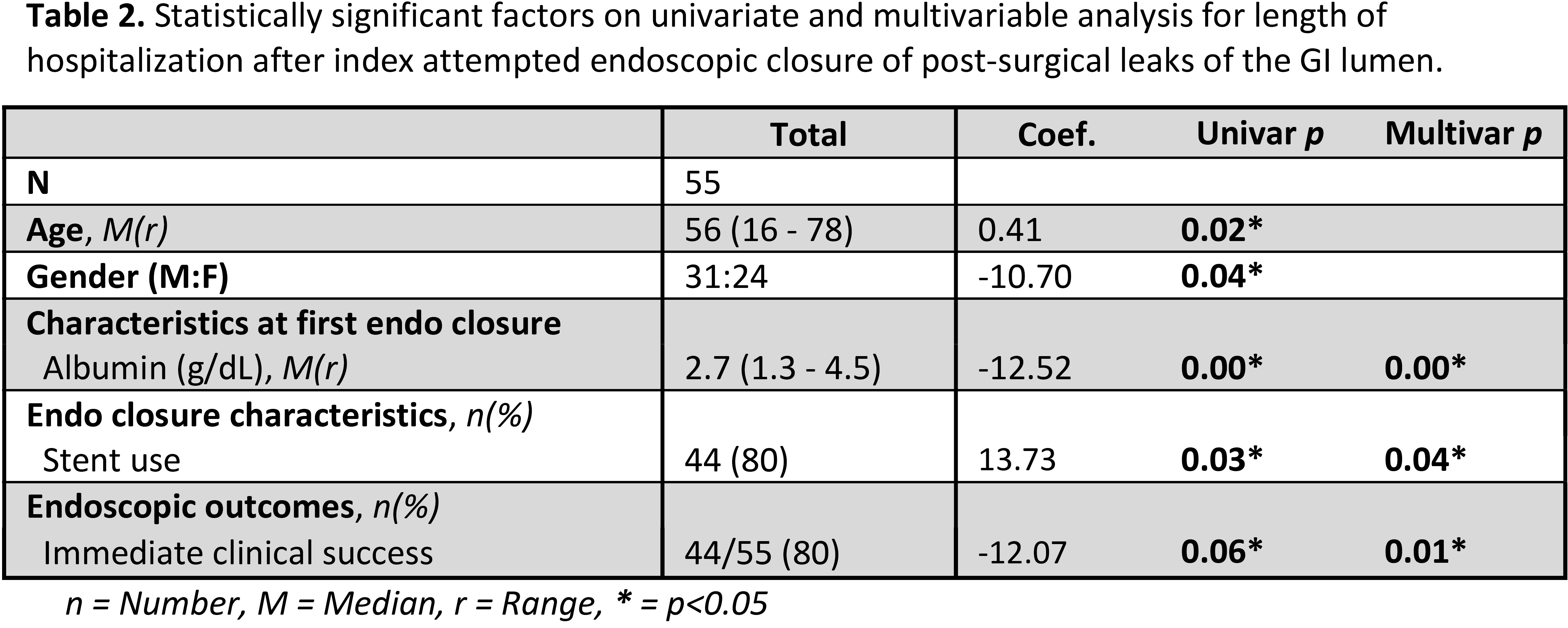TECHNICAL SUCCESS IS THE SOLE PREDICTOR OF SUCCESSFUL ENDOSCOPIC CLOSURE OF POST-SURGICAL GASTROINTESTINAL LEAKS: A MULTICENTER NORTH AMERICAN COHORT
Antonio R. Cheesman*1, Habeeb Salameh1, GAURAV KAKKED1, Rebekah E. Dixon1, Daniel J. Stein2, Tyler M. Berzin2, Prashant Kedia3, Jose Nieto4, Abdulhameed M. Al-Sabban5, Kristen Koller5, Vivek Kumbhari5, Christopher J. DiMaio1, Satish Nagula1, Nikhil A. Kumta1
1Gastroenterology, Mount Sinai Hospital, New York, NY; 2BIDMC/Harvard Medical School, Boston, MA; 3Methodist Dallas Medical Center, Dallas, TX; 4Borland Groover Clinic, Jacksonville, FL; 5Sibley Memorial Hospital - Johns Hopkins Medicine, Baltimore, MD
Background: Endoscopic management of post-surgical gastrointestinal (GI) leaks remains controversial. Management options include conservative therapy, interventional radiology (IR) drainage, endoscopic closure, and surgical repair. We aim to evaluate outcomes of endoscopic closure in post-surgical GI luminal leaks.
Methods: We conducted a multicenter retrospective study from 5 North American referral centers. All patients underwent attempted endoscopic closure for post-surgical GI leaks. Data was collected pertaining to patient demographics, clinical and surgical history, leak identification and location, and endoscopic interventions. Primary outcomes evaluated were technical success, immediate clinical success (30 days), and long-term clinical success (90 days). Length of hospital stay (LOS) was evaluated as a secondary outcome to identify factors associated with efficient leak management. Fisher's exact test, univariate, and multivariable regression were used for analysis.
Results: A total of 55 patients underwent 118 endoscopic closure procedures. Patient demographics and clinical features at index endoscopic closure are listed in Table 1. Technical success was 96.4%. Immediate clinical success was 80%. Long-term clinical success was achieved in 80% (24/30); 95.8% of which had previously attained immediate success. Surgical indications included bariatric (23), oncologic (21) and other benign GI surgery (11). Leak location included gastric (24), anastomoses (15), and esophageal (12). Median time to leak identification was 10 days. IR drainage and surgical repair were attempted prior to endoscopic therapy in 32.7% and 20% of cases. Median time from leak identification to index and final endoscopic closure attempts were 5 and 47 days respectively. Patients underwent a median of 2 (range 1-5) endoscopic sessions. Multiple endoscopic closure modalities were used in 49.1% of cases. The most common modalities used were stents 80%, over-the-scope clips 38.2%, endoscopic suturing 27.3%, and through-the-scope clips 5.5%. Adverse events occurred in 32.7% of patients, including: stent migration 25.5%, pain 3.6%, and bleeding 3.6%. Technical success was the sole predictor of immediate clinical success (p=0.04). None of the other examined factors (Table 1) were associated with immediate clinical success. Significant predictors of increased LOS were increased age, male gender, low albumin, and stent use on univariate analysis. Low albumin, stent use, and lack of immediate clinical success were significant predictors of increased LOS on multivariable analysis (Table 2).
Conclusion: Endoscopic closure of post-surgical GI luminal leaks is safe and effective with high rates of technical, immediate and long-term clinical success. Technical success was the sole predictor of immediate clinical success which in turn was associated with good long-term clinical outcomes.
Univariate analysis for immediate clinical outcome for attempted endoscopic closure of post-surgical leaks of the gastrointestinal lumen.
Statistically significant factors on univariate and multivariable analysis for length of hospitalization after index attempted endoscopic closure of post-surgical leaks of the GI lumen.
Back to 2019 Abstracts




